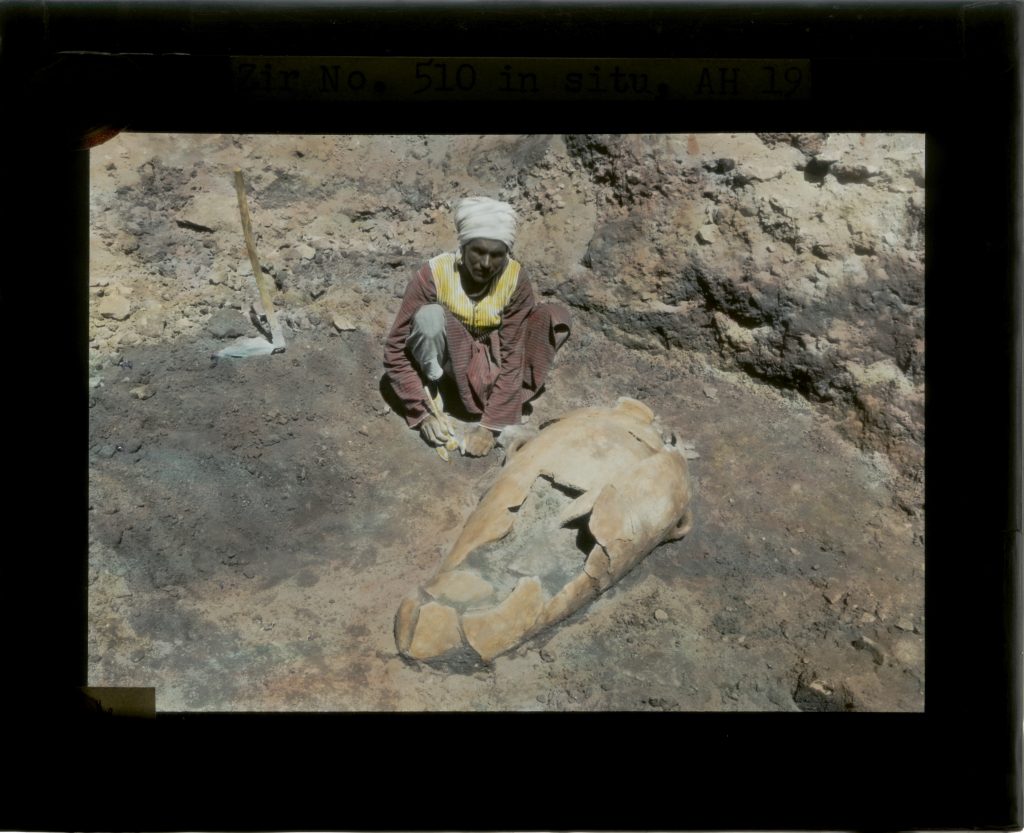


By Dr. Aaron J. Brody
Robert and Katherine Riddell Associate Professor of Bible and Archaeology
Director of the Badè Museum of Biblical Archaeology
Pacific School of Religion

By Dr. Roy J. King
Associate Professor of Psychiatry and Behavioral Science, Emeritus
Stanford University
Who were the ancient Israelites? This question has been endlessly debated but almost no attention has been paid to their biology. That is now about to change, and review of modern DNA studies gives hints to the wealth of information that might be gleaned.
This is a call for the need for DNA sampling on human skeletal materials from the region. Our hope is that testing ancient DNA will give us greater understanding of the peoples of the southern Levant, and scientific data regarding ancient groups and identities. A database of ancient DNA will also allow for comparisons with modern DNA samples collected throughout the greater region and the Mediterranean littoral, giving a better understanding of the long historical development of regional populations. But without sampling of ancient DNA we may never know.
The need to sample ancient human DNA also comes with a caveat regarding ancient human identities and fractious modern political and social situations throughout the region. We wish to stress that our reconstruction of ancient group identities through archaeology says nothing about modern political claims in the Middle East.
Today there remain legal and political impediments to gathering DNA samples from ancient skeletal materials uncovered in the modern state of Israel. In general, excavating or disturbing Jewish graves is considered immoral by ultra-Orthodox groups, who exert political pressure to ensure that state-funded construction projects, such as roadways and other public works, do not impact Jewish burials. Graves that cannot be avoided are typically excavated in a rushed manner, and skeletal materials are re-buried as quickly as possible with no time for analysis or sampling.
This is one reason there have been so few studies of ancient human DNA in the southern Levant. But obstructions within modern Israel do not negate the possibility of sampling remains housed in collections located outside of the region, or those of the Departments of Antiquities of the Palestinian Authority and the Kingdom of Jordan.

Modern DNA analyses give an indication of what might be learned from ancient studies. They also reflect the outcome of population movements that began in during the Iron Age and earlier. Although many modern DNA studies using Y chromosome (which among other things determines sex) and autosomal genome markers (the 22 numbered pairs of chromosomes) have been published for Levantine, Arabian, Turkish and Jewish populations, DNA frequencies from existing groups may not necessarily reflect the ancient population structure of these regions. Multiple migrations and population movements, such as the Assyrian and Babylonian exiles, Phoenician and Greek colonization, Persian, Hellenistic, and Roman hegemony, immigration of Arabian populations during the initial stages of Islamic conquests, and the Crusades, may have had a profound effect on the distribution of both Y chromosome and autosomal markers.
Here, rather than using the framework of historic nations, regions, and populations, we will divide the geographic space into three domains, Mediterranean, Arabian Peninsula and Southern Anatolia, and Northern Mesopotamia and the Northwest Iranian Fertile Crescent.
The Mediterranean Sea borders on three continental areas, North Africa, West Asia and South Europe. The climate and geology of the areas bordering on the Mediterranean share a common climate and landscape. Moreover, the Mediterranean has been traversed both locally and across long distances by maritime transport for millennia. The French historian Fernand Braudel considered the Mediterranean to be a geographic/cultural unit whose commonalities surpass the conventional subdivision of geography into continents such as Europe or Asia.
Braudel also viewed Mediterranean history through a broad temporal and spatial lens, which he termed “la longue durée,” rather than specific social-historical events such as conflict between states or empires. Braudel’s model of Mediterranean culture could pose an alternative way of analyzing human population genetic data of the region. Most genetic studies tend to divide populations according to continental, national, ethnic, and linguistic barriers rather than considering the Mediterranean as a unit.
The southern Levant lies at the confluence of these three domains. The eastern Mediterranean coast was the point into which the so-called “Sea Peoples” may have migrated at the end of the Late Bronze Age and from which the Canaanites and later the Phoenicians engaged in sea-faring trade. For millennia nomadic and semi-nomadic groups moved through the Arabian deserts, and it was in the coastal mountains of Lebanon and Syria-Palestine that the Neolithic economy of wheat, barley, and domesticated sheep-goat, cattle and pig, developed. In this light we turn to DNA evidence that may shed light on the origin of the Israelite people.
Most published autosomal studies that include Levantine populations utilize hundreds to thousands of DNA sequences. A study on multiple Jewish populations found the Ashkenazi and Sephardic Jews clustered with Cypriots and were situated between Druze, from Israel, and Armenians. Other Levantine populations, such as Lebanese and Syrians were slightly more distant from these Jewish populations, while populations further south in the Arabian Peninsula, Palestinians, Jordanians, Bedouins from Israel, and Saudis were even more distant.
Another study analyzed three Lebanese populations, Christian, Muslim, and Druze and found that Ashkenazi and Sephardic Jews clustered with Lebanese Christians and Druze. Lebanese Muslims fell close to Syrians. A statistical analysis of world populations revealed a Levantine component dominant in Anatolian, Iranian, Armenian, Cypriot, Ashkenazi and Sephardic Jews, and Lebanese Christians and Druze, in contrast to a Middle Eastern component that was dominant in Bedouins, Saudis, Ethiopians, and Moroccans. These cluster on the Mediterranean coastal region and the Northern Fertile Crescent in contrast to the Arabian and North African regions.

Both these studies support the hypothesis that Ashkenazi and Sephardic populations, to the extent that they may form a palimpsest of the Iron Age Israelites, may also reflect indigenous Late Bronze Age Canaanites. Geographically, Canaanite archaeological material culture, and the rare textual and linguistic evidence point to the hub of Canaanite culture along the coast of Lebanon and Northern Israel, as well as inland to the Galilee region up to the Beka’a valley. The genetic affinities of the Jewish populations with Druze and Lebanese may reflect a common Canaanite substrate.
The Y chromosome, on account of its haploid or divided state, often enables specific lineages to be traced through migrations and temporal demographic events. In the three regions under consideration, Y haplogroup J-M304 is the most frequent, and splits into J1 and J2. It has been shown that subclades (further subdivisions) J2a and J1e track the annual rainfall patterns of the Middle East with J2a more frequent in the higher rainfall areas of Anatolia and the coastal Levant as well as Crete, Cyprus, and Sicily. J1e on the other hand correlates to a low rainfall pattern of the Mid-East Arabian Desert.



This geographic distribution of J2a versus J1 mirrors the two autosomal components, where a Levantine component is dominant in Anatolian, Iranian, Armenian, Cypriot, Ashkenazi and Sephardic Jews, and Lebanese Christians and Druze, and a Middle Eastern component that is dominant in Bedouins, Saudis, Ethiopians, and Moroccans. Several demographic and migration events may contribute to the observed patterns. Major J2a lineages with likely origins in East Anatolia, Armenia, Georgia, and NW Iran could have migrated to the southern Levant during the Early Bronze Age through the “Khirbet Kerak” culture. Later immigration from a similar East Anatolian source may have occurred during the Middle Bronze Age. These events may have added J2a to an underlying J1 substratum. Analogously, J1 chromosomes may have amplified during the many episodes of sedentarization of nomadic and semi-nomadic populations from the Arabian Desert. Finally, other Y lineages may have moved into the coastal southern Levant from the Aegean during the collapse of the Late Bronze Age states.
The Y chromosome patterns of contemporary populations offers a lens to explore the possible demographic effects of the Iron Age I Philistines. Apart from the J2a patterns listed above, previous studies show an Aegean focus for two non-J Y lineages. Both lineages track Greek colonization events from present day Southern France to Greek colonies in Ukraine and Crimea.

Modern DNA studies throughout the southern Levant, Middle East, and Mediterranean are only imprecisely connected to ancient social history. But by sampling skeletal materials from the southern Levant from secure archaeological contexts, we can begin to build an ancient DNA database. This database would provide ancient genetic information that we could then compare with our archaeological reconstruction of varied ethnic groups in the southern Levant in the Iron I and other periods. Ancient DNA may also be compared with modern DNA in order to better refine our understanding of the long-term histories of human groups and their interactions in the southern Levant.
Originally published by Friends of ASOR, The Ancient Near East Today III:6 (June 2015), under the terms of a Creative Commons Attribution-NonCommercial-ShareAlike 4.0 International license.






